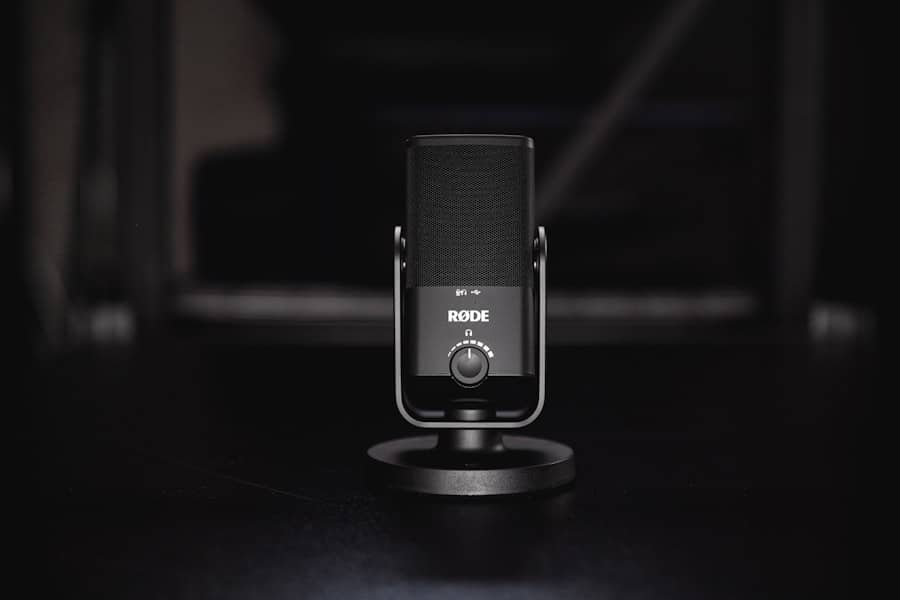Voice-controlled gaming represents a significant evolution in the way players interact with video games. This technology leverages advanced speech recognition systems, allowing players to control game mechanics and navigate virtual environments using their voice. The advent of voice recognition technology has transformed not only how games are played but also who can play them.
With the integration of artificial intelligence and natural language processing, voice-controlled gaming has become more intuitive and responsive, creating a more immersive experience for users. This shift is particularly noteworthy in an era where inclusivity and accessibility are paramount in the gaming industry. The rise of voice-controlled gaming can be traced back to the early 2010s, when developers began experimenting with voice commands in various gaming platforms.
Initially, these features were limited and often unreliable, but advancements in technology have led to significant improvements. Today, major gaming consoles and platforms, such as Xbox and PlayStation, incorporate voice recognition capabilities that allow players to issue commands, search for games, and even communicate with other players through voice chat. This evolution not only enhances gameplay but also opens up new avenues for engagement, making gaming more accessible to a broader audience.
Key Takeaways
- Voice-controlled gaming allows players to interact with games using their voice, providing a new level of accessibility and immersion.
- The benefits of voice-controlled gaming for accessibility include increased independence for players with physical disabilities and a more inclusive gaming experience for all.
- However, voice-controlled gaming also presents limitations and challenges for accessibility, such as potential issues with speech recognition and language barriers.
- The future of voice-controlled gaming technology holds promise for continued advancements in accessibility and a more seamless gaming experience for all players.
- Voice-controlled gaming has the potential to have a significant impact on the gaming industry, driving innovation and creating new opportunities for inclusive gaming experiences.
The Benefits of Voice-Controlled Gaming for Accessibility
One of the most compelling advantages of voice-controlled gaming is its potential to enhance accessibility for players with disabilities. Traditional gaming interfaces often rely heavily on physical inputs, such as controllers or keyboards, which can pose significant challenges for individuals with mobility impairments. Voice recognition technology allows these players to engage with games in ways that were previously impossible.
For instance, a player with limited hand mobility can issue commands verbally, enabling them to participate fully in gaming experiences without the need for specialized equipment. Moreover, voice-controlled gaming can also benefit individuals with visual impairments. Many modern games include complex menus and intricate navigation systems that can be difficult for visually impaired players to navigate using traditional methods.
By utilizing voice commands, these players can access game menus, receive auditory feedback, and interact with game elements more easily. This not only enhances their overall gaming experience but also fosters a sense of independence and empowerment, allowing them to enjoy games on their own terms.
The Limitations and Challenges of Voice-Controlled Gaming for Accessibility

Despite its numerous benefits, voice-controlled gaming is not without its limitations and challenges. One significant hurdle is the accuracy of voice recognition technology. While advancements have been made, many systems still struggle to accurately interpret commands in noisy environments or when players have accents or speech impediments.
This can lead to frustration and hinder the overall gaming experience. For instance, a player may find themselves repeatedly issuing the same command only to have the system misinterpret it, resulting in a loss of immersion and enjoyment. Additionally, the reliance on voice commands can create barriers for certain individuals.
For example, players who are non-verbal or have difficulty producing speech may find themselves excluded from voice-controlled gaming experiences altogether. While some systems offer alternative input methods, such as gesture recognition or eye-tracking technology, these solutions are not universally available or effective. As a result, there remains a need for developers to create more inclusive systems that accommodate a wider range of abilities and preferences.
The Future of Voice-Controlled Gaming Technology
Looking ahead, the future of voice-controlled gaming technology appears promising as innovations continue to emerge. One area of development is the integration of artificial intelligence (AI) to enhance the responsiveness and adaptability of voice recognition systems. AI algorithms can learn from user interactions, improving their ability to understand context and nuances in speech over time.
This could lead to more seamless interactions where players can issue complex commands or engage in natural conversations with in-game characters.
As developers prioritize accessibility in their design processes, we may see an increase in customizable voice command options that allow players to tailor their gaming experience according to their individual needs.
This could include the ability to create personalized command phrases or adjust sensitivity settings based on the player’s unique vocal characteristics.
The Impact of Voice-Controlled Gaming on the Gaming Industry
The introduction of voice-controlled gaming has had a profound impact on the gaming industry as a whole. It has prompted developers to rethink traditional gameplay mechanics and explore new ways to engage players. As voice recognition technology becomes more prevalent, game designers are increasingly incorporating voice commands into their titles, creating unique gameplay experiences that differentiate them from competitors.
This shift has led to a surge in innovative game design that prioritizes player interaction through natural language. Moreover, the rise of voice-controlled gaming has influenced marketing strategies within the industry. Companies are now highlighting accessibility features as key selling points for their products, recognizing that a more inclusive approach can attract a wider audience.
This trend is evident in the growing number of games specifically designed for players with disabilities, showcasing how voice control can enhance gameplay for everyone. As awareness of accessibility issues continues to grow, it is likely that more developers will prioritize inclusive design principles in their projects.
The Role of Voice-Controlled Gaming in Inclusive Gaming

Enhancing Social Interaction and Teamwork
Multiplayer games that incorporate voice chat features have enabled players with disabilities to communicate and collaborate with others in real-time, enhancing social interaction and teamwork. This has opened up new opportunities for players who were previously excluded from participating in gaming experiences.
Amplifying Inclusivity through Streaming Platforms
The rise of streaming platforms has further amplified the importance of inclusivity in gaming. Streamers who utilize voice-controlled features can engage with their audiences in new ways, creating interactive experiences that resonate with viewers from various backgrounds. This not only broadens the appeal of streaming content but also encourages discussions around accessibility and representation within the gaming community.
A Brighter Future for Inclusive Gaming
As more gamers advocate for inclusive practices, the industry is likely to see continued growth in voice-controlled features that cater to diverse audiences. This shift towards inclusivity is expected to have a profound impact on the gaming industry, creating a more welcoming and diverse community for gamers from all walks of life.
The Potential for Voice-Controlled Gaming in Other Industries
Beyond the realm of entertainment, voice-controlled technology holds significant potential across various industries. In education, for example, voice recognition systems can facilitate learning by allowing students to interact with educational software through spoken commands. This can be particularly beneficial for young learners or those with learning disabilities who may struggle with traditional input methods.
By creating an engaging and interactive learning environment, educators can harness the power of voice control to enhance student participation and comprehension. In healthcare, voice-controlled technology can streamline patient interactions and improve accessibility for individuals with disabilities. Medical professionals can use voice commands to access patient records or input data hands-free while attending to patients directly.
This not only increases efficiency but also enhances patient care by allowing healthcare providers to focus on their interactions rather than being distracted by manual data entry tasks.
The Future of Voice-Controlled Gaming for Accessibility
As we look toward the future of voice-controlled gaming technology, it is clear that its potential for enhancing accessibility is vast and multifaceted. While challenges remain in terms of accuracy and inclusivity for all users, ongoing advancements in AI and machine learning promise to address these issues over time. The gaming industry is increasingly recognizing the importance of accessibility as a core component of game design, paving the way for more inclusive experiences that cater to diverse player needs.
The impact of voice-controlled gaming extends beyond entertainment; it has implications for education, healthcare, and other sectors where accessibility is crucial. By embracing this technology and prioritizing inclusive design principles, we can create a future where everyone has the opportunity to engage with games and other interactive experiences on their own terms. As developers continue to innovate and push boundaries, the landscape of gaming will evolve into one that celebrates diversity and fosters connection among all players.
If you are interested in exploring the latest trends in technology, you may want to check out the article Top Trends on Instagram 2023. This article discusses the upcoming trends on one of the most popular social media platforms, providing valuable insights for those looking to stay ahead of the curve. Just like voice-controlled gaming, staying informed about the latest trends can help individuals make informed decisions about their technology choices.
FAQs
What is voice-controlled gaming?
Voice-controlled gaming is a type of gaming that allows players to control the game using their voice commands instead of traditional controllers or keyboards. This technology uses speech recognition to interpret and execute the player’s commands within the game.
How does voice-controlled gaming benefit accessibility?
Voice-controlled gaming can benefit accessibility by providing an alternative way for individuals with physical disabilities to play video games. It allows players with limited mobility or dexterity to participate in gaming experiences that may have been inaccessible to them with traditional controllers.
What are the potential future advancements in voice-controlled gaming for accessibility?
The future of voice-controlled gaming for accessibility may include advancements in speech recognition technology to improve accuracy and responsiveness. Additionally, developers may focus on creating more customizable and adaptable voice control options to cater to a wider range of accessibility needs.
What are the challenges of voice-controlled gaming for accessibility?
Challenges of voice-controlled gaming for accessibility may include limitations in speech recognition accuracy, potential privacy concerns related to voice data collection, and the need for developers to ensure that voice control options are inclusive and customizable for diverse accessibility needs.
How can voice-controlled gaming be integrated into mainstream gaming platforms?
Voice-controlled gaming can be integrated into mainstream gaming platforms through collaboration between game developers and accessibility advocates to ensure that voice control options are included in game design. Additionally, platform developers can work to incorporate voice recognition technology into their systems to support accessibility features.

